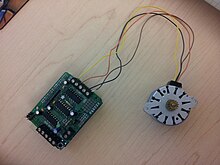Arduino/Junk pile stepper motor survey
Appearance
< Arduino
The purpose of this page is to record the wiring of junked stepper motors to arduino motor shields.

Stepper motors have 4 or more wires going into them. Not all motors with 4 or more wires are stepper motors. Typically these motors do not settle down and display a constant ohm value. Instead the resistance reading go to zero or infinity. Switching the polarity of the probes measuring resistance causes different resistance values.
Arduino Code
| ||
|---|---|---|
|
There are two adafruit motor shield versions, with different libraries: The sparkfun monster motor shield only comes with an example, not a library.
|
Next Steps
[edit | edit source]- Attach motor shield to larger power source .. 9-12volts .. perhaps up to 1.5amps. See how motor strength improves and how chips on motor shield heat up.
- Get spark fun motor shields working .. suppose to handle more power
- Count teeth on the gears to see if there are standards that can be leveraged
- Research PC power supply specifications to see if they are going to be useful
- Figure out how fast the motors can rotate .. some seem pretty slow .. this may be due to the stepper motor program or sketch.











